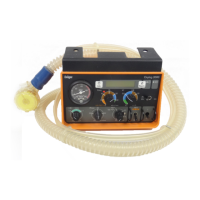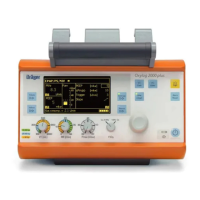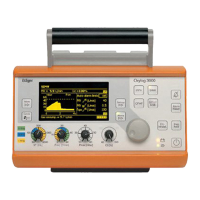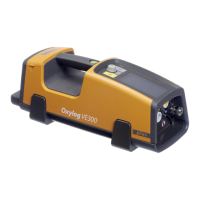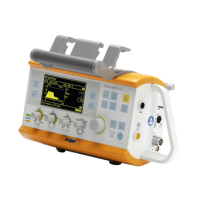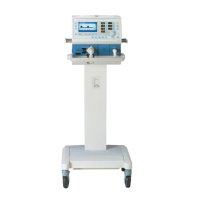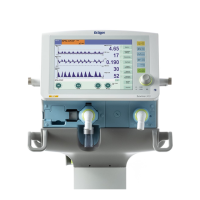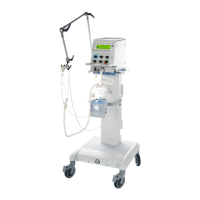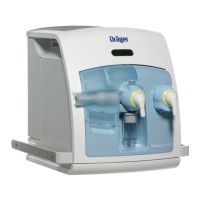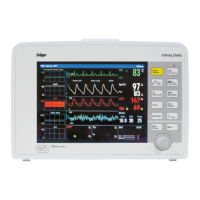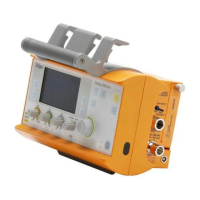
Do you have a question about the Dräger Oxylog 2000 plu and is the answer not in the manual?
| Category | Medical Equipment |
|---|---|
| Type | Transport Ventilator |
| Tidal Volume | 50 to 2000 mL |
| PEEP | 0 to 20 cmH2O |
| Display | Monochrome LCD |
| Inspiratory Time | 0.2 to 5 s |
| FiO2 | 21 to 100% |
| Power Supply | 100 to 240 V AC, 50/60 Hz |
| Ventilation Modes | IPPV, SIMV, CPAP |
Covers following instructions, general warnings, EMC risks, and installation safety.
Details patient safety, monitoring responsibilities, and functional safety aspects.
Provides general warnings and cautions for device operation and installation.
Defines the device's intended purpose and conditions where its use is contraindicated.
Specifies acceptable locations and conditions for device operation.
Identifies all buttons, keys, and controls on the device's front panel.
Describes side, rear views, and key components like air intake and rating plate.
Details reusable/disposable hose systems and available ventilation modes.
Explains special ventilation modes and monitored parameters like Apnea.
Lists all abbreviations and symbols used throughout the manual.
Covers switching the device ON/OFF and understanding battery status indicators.
Explains how to select and set ventilation modes and operational parameters.
Guides users through screen pages, windows, and specific display readouts.
Explains the concept of dead space in ventilation systems and its implications.
Instructions for assembling reusable and disposable hose systems.
Details connecting power supplies, replacing, and checking the battery.
Instructions for connecting oxygen cylinders or piped gas systems safely.
Guidance on securely hanging the device on standard rail systems.
Procedures for charging the battery and interpreting its capacity and operation status.
How to estimate the pneumatic operating time based on gas supply.
Steps for checking device readiness, performing self-tests, and troubleshooting.
Covers initial startup, device self-test, and preparing ventilation modes.
Details setting up various ventilation modes like VC-CMV, VC-SIMV, and SpnCPAP.
Explains Non-Invasive Ventilation (NIV) and O2 AirMix/100% O2 settings.
Covers calibration, screen brightness, volume, and device shutdown procedures.
Describes different alarm priorities (Warning, Caution, Advisory) and their indicators.
Procedures for responding to alarms, silencing tones, and handling gas/power failures.
How to manually and automatically set alarm limits for parameters like MV and RRsp.
Instructions on viewing airway pressure readings on the display.
How to view MVe and VTe (minute/tidal volume) values on the display.
Guides on viewing O2 concentration and other selected measured values.
Setting device parameters, language, and viewing configuration information.
Accessing and using the service mode for tests, settings, and diagnostics.
Configuring startup parameters and selecting the ventilation hose system type.
Setting device date/time and customizing the measured values display window.
Detailed table of alarms, their causes, and recommended remedies.
Explanations for messages appearing in the device's information window.
Troubleshooting error messages encountered during the device self-check.
Step-by-step instructions for taking apart hose systems and breathing valves.
Guidance on cleaning, disinfecting, and sterilizing reusable device components.
Post-cleaning procedures and important notes on hose system durability.
Recommended schedule and specific tasks for regular device maintenance.
Instructions on what to do in case of device damage or malfunction.
Information on safe disposal practices and compliance with EU directives.
Procedures for the proper disposal of the internal battery and the medical device.
Guidelines for the correct disposal of disposable hose systems per regulations.
Specifies operating, storage, and transport environmental parameters like temperature and humidity.
Lists adjustable parameters and device performance characteristics.
Details the range, resolution, and display of measured values and monitoring parameters.
Information on battery, operating times, and power supply requirements.
Covers device specifications, materials, EMC compliance, and safety classifications.
Detailed explanation of VC-CMV, VC-AC, and VC-SIMV ventilation modes.
How pressure support is applied and terminated for patient breathing assistance.
Overview of the device's internal systems, gas flow, and safety mechanisms.
Lists the main device, workstation, power supply, and available cables.
Details reusable, disposable hose systems, and conversion kits.
Lists items like holders, chargers, test lungs, and optional features like PS/NIV.
